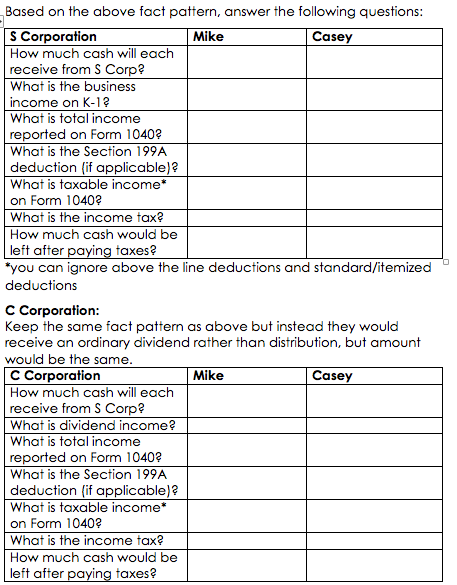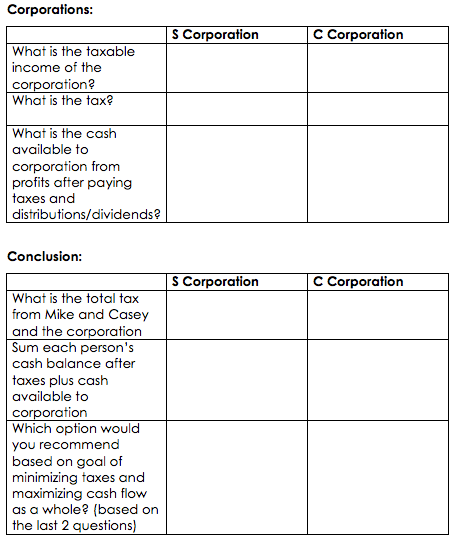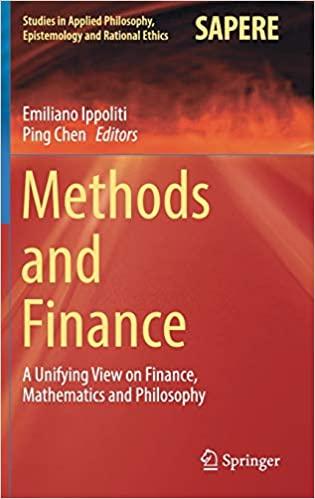
Show all math used**


Mike and Casey are siblings that have started their own business. When they first created their business, they formed an S Corporation They are considering changing to a C Corporation and but first want to know the tax implications to each of them individually as well as the corporation. Mike owns 40% and Casey owns 60% of the business. Mike works full- time at the business and takes a salary of $50,000. . For 2019, they expect their profits to be $500,000 before paying a salary to Casey . They also plan on taking a total distribution of $100,000 (allocated based on ownership percentage) . For this project, assume that all business transactions are cash transactions. . All business income of the S Corporation is eligible for Section 199A deduction for Mike and Casey. . Mike and Casey also have other sources of income, which you will ignore, except that you need to know that Mike's marginal tax rate is 24% and Casey's marginal tax rate is 32%. . You can ignore all self-employment taxes. Based on the above fact pattern, answer the following questions: s Corporation Mike Casey How much cash will each receive from S Corp? What is the business income on K-12 What is total income reported on Form 1040? What is the Section 199A deduction (if applicable) What is taxable income* on Form 10402 What is the income tax? How much cash would be left after paying taxes? "you can ignore above the line deductions and standard/itemized deductions C Corporation: Keep the same fact pattern as above but instead they would receive an ordinary dividend rather than distribution, but amount would be the same. C Corporation Mike Casey How much cash will each receive from S Corp? What is dividend income? What is total income reported on Form 1040? What is the Section 199A deduction (if applicable) What is taxable income* on Form 10402 What is the income tax? How much cash would be left after paying taxes? Corporations: s Corporation Corporation What is the taxable income of the corporation What is the tax? What is the cash available to corporation from profits after paying taxes and distributions/dividends? Conclusion: s Corporation Corporation What is the total tax from Mike and Casey and the corporation Sum each person's cash balance after taxes plus cash available to corporation Which option would you recommend based on goal of minimizing taxes and maximizing cash flow as a whole? (based on the last 2 questions) Mike and Casey are siblings that have started their own business. When they first created their business, they formed an S Corporation They are considering changing to a C Corporation and but first want to know the tax implications to each of them individually as well as the corporation. Mike owns 40% and Casey owns 60% of the business. Mike works full- time at the business and takes a salary of $50,000. . For 2019, they expect their profits to be $500,000 before paying a salary to Casey . They also plan on taking a total distribution of $100,000 (allocated based on ownership percentage) . For this project, assume that all business transactions are cash transactions. . All business income of the S Corporation is eligible for Section 199A deduction for Mike and Casey. . Mike and Casey also have other sources of income, which you will ignore, except that you need to know that Mike's marginal tax rate is 24% and Casey's marginal tax rate is 32%. . You can ignore all self-employment taxes. Based on the above fact pattern, answer the following questions: s Corporation Mike Casey How much cash will each receive from S Corp? What is the business income on K-12 What is total income reported on Form 1040? What is the Section 199A deduction (if applicable) What is taxable income* on Form 10402 What is the income tax? How much cash would be left after paying taxes? "you can ignore above the line deductions and standard/itemized deductions C Corporation: Keep the same fact pattern as above but instead they would receive an ordinary dividend rather than distribution, but amount would be the same. C Corporation Mike Casey How much cash will each receive from S Corp? What is dividend income? What is total income reported on Form 1040? What is the Section 199A deduction (if applicable) What is taxable income* on Form 10402 What is the income tax? How much cash would be left after paying taxes? Corporations: s Corporation Corporation What is the taxable income of the corporation What is the tax? What is the cash available to corporation from profits after paying taxes and distributions/dividends? Conclusion: s Corporation Corporation What is the total tax from Mike and Casey and the corporation Sum each person's cash balance after taxes plus cash available to corporation Which option would you recommend based on goal of minimizing taxes and maximizing cash flow as a whole? (based on the last 2 questions)









